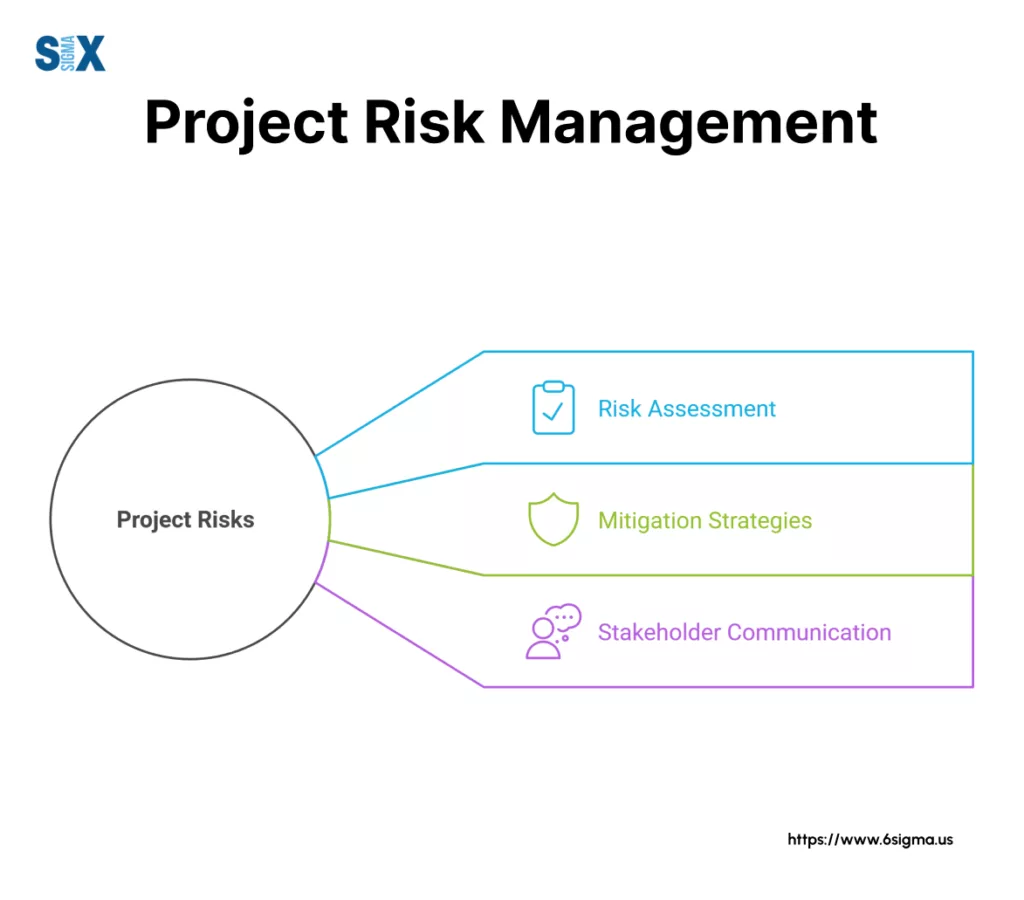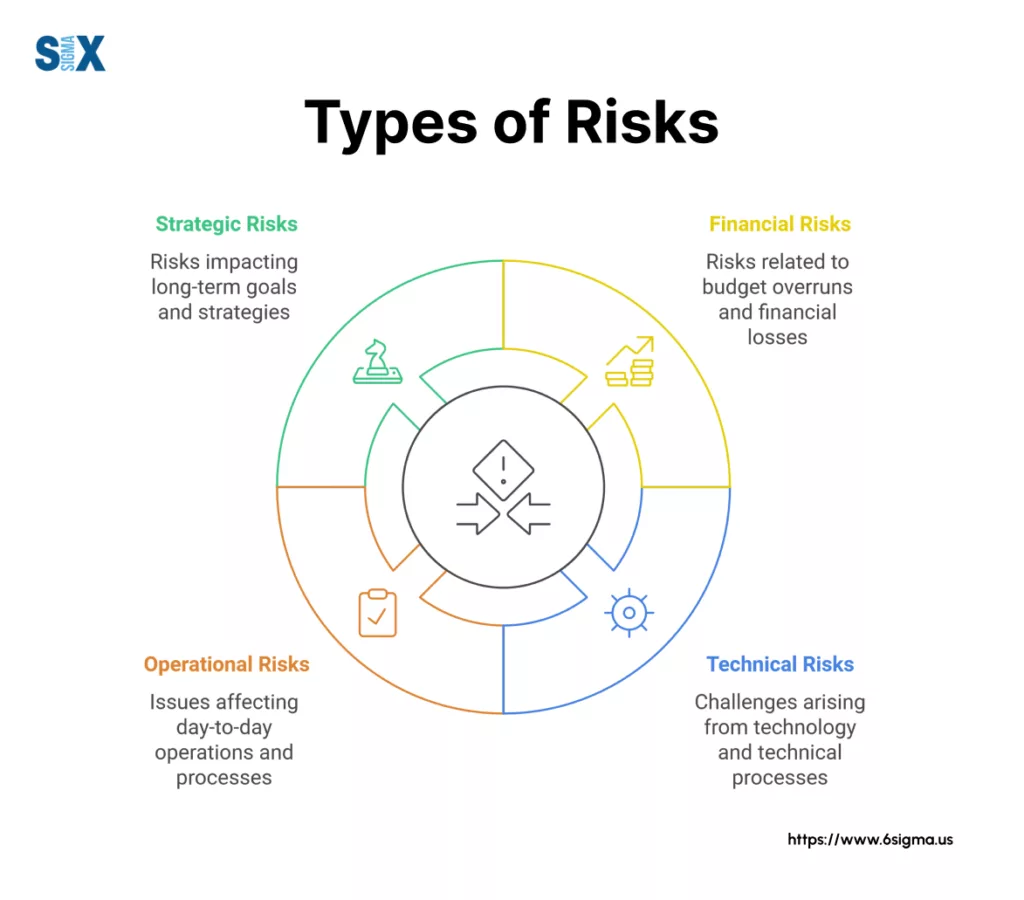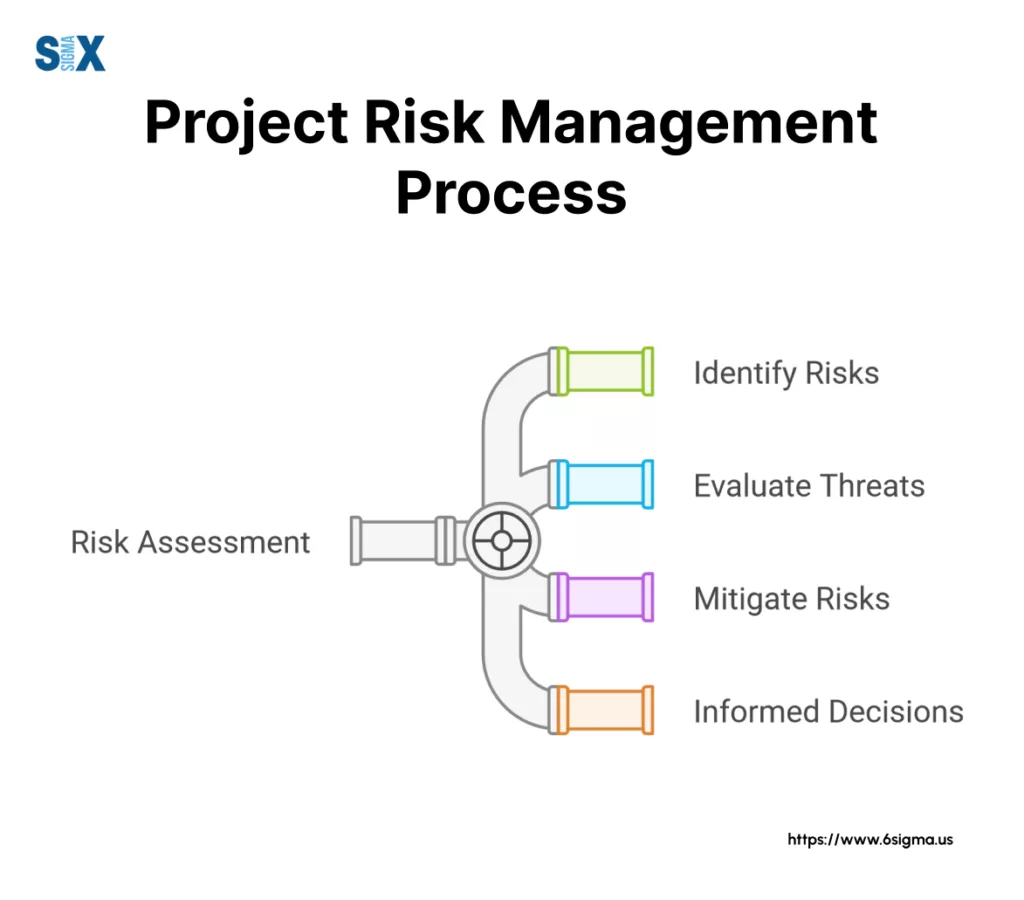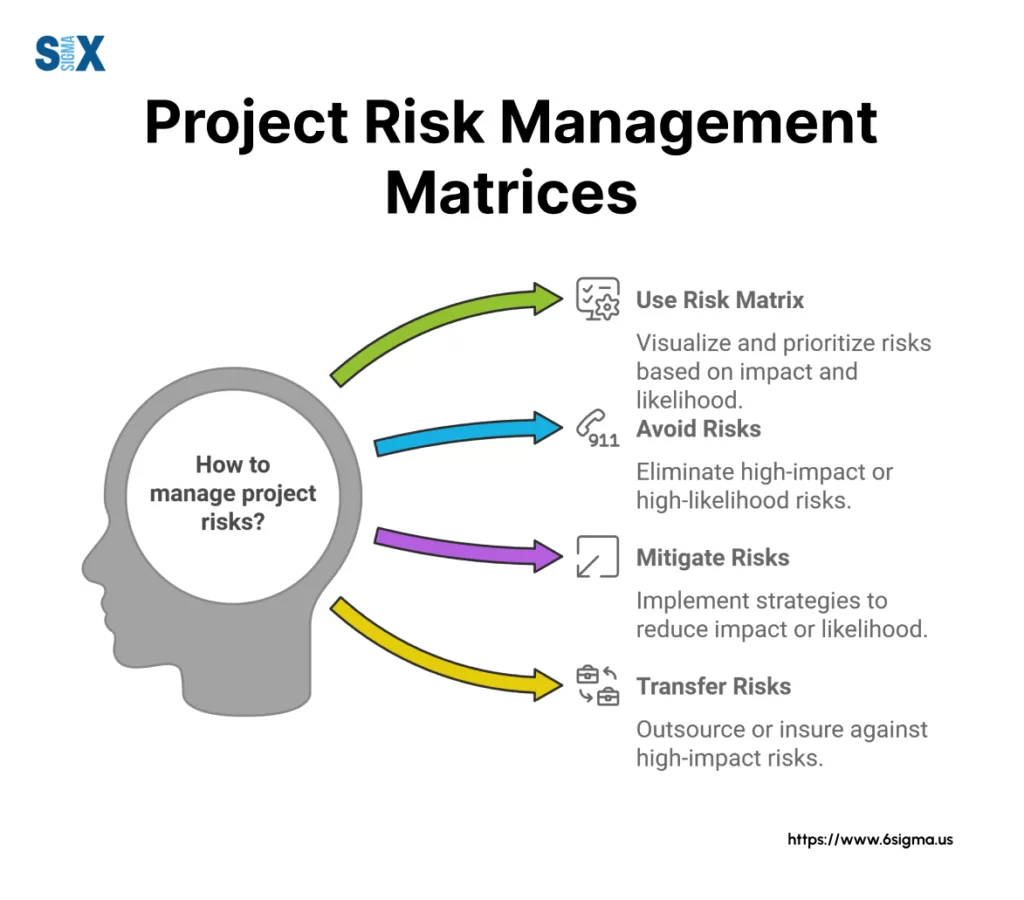Project Risk Management: Strategies, Tools, and Best Practices
In project management, the only certainty is uncertainty. That’s where project risk management comes in.
As projects become increasingly complex and interconnected, the ability to anticipate, assess, and mitigate risks has become a critical skill for project managers at all levels. Earning a six sigma certification can equip professionals with the tools to streamline processes and proactively manage project risks.
Project risk management is the systematic process of identifying, analyzing, and responding to potential threats and opportunities that could impact a project’s objectives.
It’s not just about avoiding problems; it’s about proactively managing uncertainties to maximize the chances of project success.
Key Highlights
- Tools to effectively manage risks in any project
- Project risk management process
- Risk assessment techniques
- Practices for developing a robust project risk management plan.
- Types of project risks
What is Project Risk Management?
Project risk management is a critical component of successful project execution.
Project risk management is the systematic process of identifying, analyzing, and responding to potential events that could impact a project’s objectives.
This proactive approach is essential for minimizing threats and maximizing opportunities throughout the project lifecycle.
The importance of project risk management cannot be overstated. It allows project managers to anticipate potential issues, allocate resources effectively, and make informed decisions. Complementing these skills with a six sigma certification can further enhance a manager’s ability to identify and eliminate inefficiencies that contribute to project risks.
Implementing a robust project risk management plan reduces project failures, cost overruns, and schedule delays; complementing these practices with methodologies learned through a six sigma certification can further enhance process efficiency and risk reduction.
By implementing a robust project risk management plan, teams can reduce the likelihood of project failures, cost overruns, and schedule delays.

The Project Risk Management Process
The project risk management process consists of several interconnected steps that form a continuous cycle throughout the project’s duration. Here’s an overview of the main steps:
- Risk Identification: Recognize and document potential risks that could affect the project.
- Risk Analysis: Evaluate the likelihood and potential impact of identified risks.
- Risk Prioritization: Rank risks based on their severity and probability.
- Risk Response Planning: Develop strategies to address high-priority risks.
- Risk Monitoring and Control: Continuously track risks and implement response plans as needed.
- Risk Review and Reporting: Regularly assess the effectiveness of risk management efforts and communicate findings to stakeholders.
This proactive approach is the cornerstone of effective project risk management.
By following these steps, project managers can stay ahead of potential issues and adapt their strategies as new risks emerge or existing ones evolve.
Mastering these steps is crucial, and structured methodologies available through a six sigma certification offer frameworks that emphasize rigorous process control and risk mitigation.
To enhance your skills in this area, consider enrolling in project risk management training courses. Additionally, a six sigma green belt certification provides hands-on training in process improvement techniques, enabling project managers to systematically address risks and optimize project outcomes.
These programs offer in-depth knowledge of risk management tools and techniques, helping you develop a comprehensive project risk management plan tailored to your specific needs.
Remember, project risk management is not a one-time activity but an ongoing process that requires constant attention and refinement.
Types of Project Risks
In project risk management, understanding the various types of risks is crucial for effective planning and mitigation.
Project managers must be adept at identifying and categorizing risks to develop a comprehensive project risk management plan.

Common Categories of Project Risks
- Financial Risks: These risks directly impact the project’s budget and can include unexpected costs, budget overruns, or changes in funding. For example, a sudden increase in material costs could significantly affect a construction project’s financial health.
- Schedule Risks: Delays and timeline issues fall under this category. These risks can stem from resource shortages, dependencies on external factors, or underestimated task durations. A software development project, for instance, might face schedule risks due to unexpected technical challenges or integration issues.
- Technical Risks: These involve risks related to the technology or technical aspects of the project. In IT projects, technical risks might include compatibility issues, software bugs, or hardware failures.
- Operational Risks: These risks are associated with the day-to-day operations of the project. They can include issues with processes, systems, or people. For example, in a manufacturing project, operational risks might involve equipment breakdowns or supply chain disruptions.
- External Risks: Factors outside the project’s control fall into this category. These can include regulatory changes, market fluctuations, or natural disasters. A global pandemic, for instance, would be considered an external risk affecting projects across various industries.
Industry-Specific Risks
Different industries face unique risks that project managers must consider in their risk management processes:
- IT Sector: Cybersecurity threats, rapid technological changes, and data privacy issues are significant risks.
- Construction Industry: Weather-related delays, safety hazards, and material shortages are common risks.
- Healthcare Projects: Regulatory compliance, patient safety concerns, and technological integration challenges are prevalent risks.
- Finance Sector: Market volatility, regulatory changes, and fraud risks are critical considerations.
Understanding these industry-specific risks is essential for tailoring your project risk management approach.
It allows you to develop more targeted risk mitigation strategies and improve the overall effectiveness of your project risk management plan.
Remember, effective project risk management is about more than just identifying risks; it’s about understanding their potential impact and developing strategies to mitigate them.
Risk Assessment Techniques
Effective project risk management hinges on the ability to accurately assess and prioritize risks. Professionals with a six sigma certification can leverage statistical tools like those taught in Six Sigma to enhance the precision of their risk assessments.
This crucial step in the project risk management process involves two primary approaches: qualitative and quantitative risk analysis.
To effectively perform both qualitative and quantitative analysis, a deep understanding of underlying issues is essential. Techniques taught in root cause analysis training are invaluable for drilling down beyond symptoms to identify the true sources of potential project risks.

Qualitative Risk Analysis
Qualitative risk analysis is a subjective approach that evaluates risks based on their probability and potential impact.
This method is particularly useful in the early stages of project risk management planning when quick assessments are needed.
Methods of qualitative analysis include:
- Risk probability and impact assessment
- Risk categorization
- Expert judgment
- Risk urgency assessment
Qualitative analysis is most effective when:
- You need a rapid assessment of risks
- The project is relatively simple or short-term
- There’s limited numerical data available
- You’re working with a tight budget for risk analysis
Quantitative Risk Analysis
Quantitative risk analysis uses numerical data and statistical techniques to calculate the probability and consequences of risks.
This approach provides more precise risk estimates, which can be crucial for complex or high-stakes projects.
Common quantitative analysis methods include:
- Monte Carlo simulation
- Decision tree analysis
- Sensitivity analysis
- Expected Monetary Value (EMV) analysis
Quantitative analysis is most beneficial when:
- You need detailed numerical risk data
- The project is complex or long-term
- Substantial historical data is available
- Stakeholders require specific risk probabilities and impacts
Risk Matrix: A Key Tool in Risk Assessment
The risk matrix is a versatile project risk management tool that combines elements of both qualitative and quantitative analysis.
It visually represents risks based on their probability and impact, allowing project managers to quickly identify which risks require immediate attention.
To create and use a risk matrix:
- Define probability and impact scales (e.g., 1-5 or Low-Medium-High)
- Plot identified risks on the matrix based on their scores
- Use color coding to highlight risk severity (e.g., green for low, yellow for medium, red for high)
- Prioritize risks in the high-probability, high-impact quadrant
The risk matrix is an essential component of any project risk management plan, offering a clear, visual representation of project risks.
It’s particularly useful for communicating risk status to stakeholders and team members who may not be versed in complex risk management processes.
To enhance your risk assessment skills, consider enrolling in project risk management training courses that cover these techniques in depth.
Many of these courses offer hands-on experience with various project risk management tools, including advanced risk matrix software.
The goal of risk assessment is not just to identify risks, but to provide actionable insights that inform your risk response strategies.

Best Practices for Risk Mitigation
Effective project risk management goes beyond identifying and assessing risks; it requires a robust strategy for mitigating potential threats and capitalizing on opportunities.
By implementing best practices in risk mitigation, project managers can significantly increase their chances of project success. Exploring lean fundamentals can further enhance these efforts by teaching managers how to eliminate waste and streamline processes, reducing the likelihood of operational risks.
Developing a Risk Management Plan
A comprehensive project risk management plan is the foundation of effective risk mitigation.
This document outlines how you’ll approach, execute, and monitor risk management activities throughout the project lifecycle. Key components of a risk management plan include:
- Risk identification methods
- Risk assessment criteria
- Risk response strategies
- Risk monitoring and control procedures
- Roles and responsibilities in risk management
Tips for creating an effective risk management plan:
- Align the plan with overall project objectives
- Involve key stakeholders in the planning process
- Use clear, concise language to ensure understanding
- Regularly review and update the plan as the project evolves
Risk Response Strategies
Once risks are identified and assessed, project managers must decide how to respond. The four primary risk response strategies are:
- Avoid: Eliminate the threat by changing project plans or objectives.
Example: Choosing a proven technology over an experimental one to avoid potential technical risks. - Transfer: Shift the impact of the risk to a third party.
Example: Purchasing insurance or outsourcing a high-risk component of the project. - Mitigate: Reduce the probability or impact of the risk to an acceptable level.
Example: Implementing additional quality control measures to reduce the risk of defects. - Accept: Acknowledge the risk and decide not to take any action unless the risk occurs.
Example: Accepting the possibility of minor schedule delays in non-critical tasks.
Choosing the right strategy depends on the nature of the risk, its potential impact, and the resources available.
Applying these risk response strategies is often more effective when coupled with principles aimed at streamlining processes and eliminating waste. An understanding of Lean Fundamentals can help identify opportunities to simplify project steps, thereby inherently reducing potential risk points.
Project risk management training courses often provide in-depth guidance on selecting and implementing these strategies effectively.
Continuous Monitoring and Updating
Risk management is an ongoing process that requires constant vigilance.
Continuous monitoring allows project managers to:
- Identify new risks as they emerge
- Reassess known risks as the project evolves
- Evaluate the effectiveness of implemented risk responses
Tools and techniques for risk monitoring include:
- Regular risk review meetings
- Risk tracking software
- Key risk indicators (KRIs)
- Project dashboards with risk metrics
By incorporating these best practices into your project risk management processes, you can create a more resilient project environment capable of adapting to challenges and seizing opportunities as they arise.
Remember, effective risk mitigation is not about eliminating all risks – it’s about managing them proactively to minimize threats and maximize potential benefits.
As you refine your risk management skills, consider exploring advanced project risk management tools and techniques to further enhance your capabilities.
Take a lead on Risk Management strategies with our Black Belt training program
Tools and Software for Project Risk Management
Project risk management tools and software play a crucial role in streamlining the risk management process.
These technologies enable project managers to identify, assess, and mitigate risks more efficiently and effectively than ever before.
Overview of Popular Risk Management Tools
There’s a wide array of project risk management tools available, each with unique features and benefits.
Here’s a comparison of some popular options:
- Microsoft Project: Ideal for large-scale projects, offering robust risk tracking and reporting capabilities.
- Primavera Risk Analysis: Specializes in quantitative risk analysis, perfect for complex projects with numerous variables.
- @Risk: Excel add-in for Monte Carlo simulation, suitable for financial risk modeling.
- Risk Register Pro: User-friendly tool for small to medium-sized projects, focusing on risk identification and tracking.
- Resolver: Comprehensive enterprise risk management software with advanced analytics features.
When choosing a project risk management tool, consider:
- Project size and complexity
- Budget constraints
- Integration with existing project management software
- Ease of use and learning curve
- Reporting and visualization capabilities
Emerging Technologies in Risk Management
Project risk management is evolving rapidly with the integration of cutting-edge technologies:
AI and Machine Learning Applications:
- Predictive risk analysis based on historical project data
- Automated risk identification from project documents and communications
- Real-time risk monitoring and early warning systems
Blockchain in Risk Management:
- Enhanced data security and transparency in risk-related transactions
- Smart contracts for automated risk response triggers
- Improved traceability in supply chain risk management
These emerging technologies are reshaping the project risk management process, offering more accurate predictions and faster response times to potential risks.
As the field of project risk management continues to advance, staying updated with the latest tools and technologies is crucial. Earning a six sigma black belt certification can provide advanced training in data-driven risk management, equipping professionals to leverage cutting-edge tools for complex projects.
Consider enrolling in project risk management training courses that cover these emerging technologies to stay ahead of the curve.
By leveraging these advanced tools and keeping an eye on emerging technologies, project managers can significantly enhance their risk management capabilities.
Remember, the key is to choose tools that align with your project’s specific needs and integrate seamlessly into your overall project risk management plan.
Conclusion
As we’ve explored guide, project risk management is a crucial aspect of successful project execution.
From understanding the fundamental project risk management definition to implementing advanced risk management processes, effective risk management can make the difference between project success and failure.
Even team members not directly leading risk management can benefit from understanding core principles. Foundational programs like Six Sigma Yellow Belt certification or even a Six Sigma White Belt certification provide valuable awareness of process improvement concepts that support overall project risk management efforts.
Let’s recap the key points we’ve covered:
- The importance of a well-structured project risk management plan
- The essential steps in the project risk management process
- Various types of project risks and how to identify them
- Risk assessment techniques and tools
- Best practices for risk mitigation and monitoring
- The role of technology in modern risk management
Remember, project risk management is not a one-time activity but an ongoing process that requires constant attention and refinement.
By integrating risk management into your project management practices, you’ll be better equipped to navigate uncertainties and drive your projects towards successful completion.
As you move forward, we encourage you to implement these risk management strategies in your next project.
Start by developing a comprehensive project risk management plan, leveraging the tools and techniques we’ve discussed.
Consider enrolling in project risk management training courses or pursuing broader frameworks like six sigma certification to further enhance your skills and stay updated with the latest trends and best practices.
The field of project risk management is evolving rapidly, with emerging technologies like AI and blockchain reshaping traditional approaches.
Stay ahead of the curve by continuously updating your knowledge and adapting your risk management processes to these new developments.
Remember, effective risk management is not about eliminating all risks – it’s about identifying, assessing, and responding to risks in a way that aligns with your project objectives.
By doing so, you’ll not only mitigate potential threats but also seize opportunities that can enhance your project’s success.
SixSigma.us offers both Live Virtual classes as well as Online Self-Paced training. Most option includes access to the same great Master Black Belt instructors that teach our World Class in-person sessions. Sign-up today!
Virtual Classroom Training Programs Self-Paced Online Training Programs







